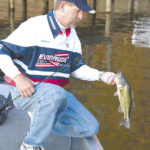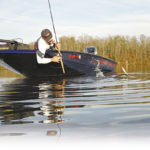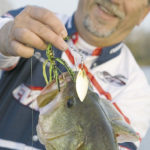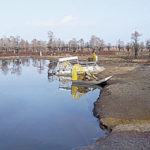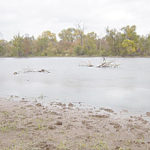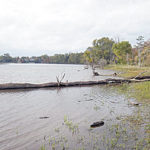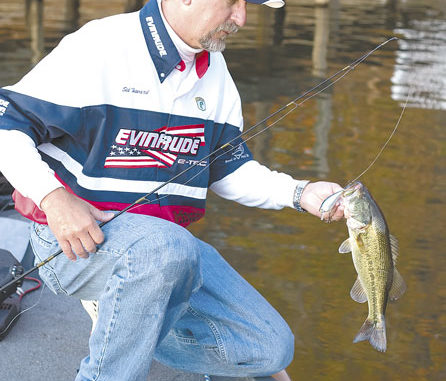
North Louisiana’s lakes are incredibly low, and that means now is the time for anglers to be on the water before this window slams shut.
If the Farmer’s Almanac and all the old folks around my house are correct, we should be right in the middle of an unusually warm and dry winter as you are reading this. La Nina, I think they call it.
I started hearing that this winter might not be very cold and wet as I was researching long-range weather patterns a few months ago. See, the food plots that I planted for the local deer population didn’t come up at all after the first planting because of the lack of rain in Southeast Louisiana.
While I thought we had it bad down here, my bass-fishing buddies from North Louisiana quickly informed me that they were much worse off. And their lack of rain wasn’t just affecting their food plots; it was affecting their fishing.
“Just about all of our lakes are pathetically low,” lamented Simsboro bass angler Sid Havard back in November. “Take D’Arbonne for instance. You couldn’t even go to the back of most of the pockets it was so low. They drew the lake down to work on the dam at (Lake) Bistineau, and it’s about 7 feet low. It’s terrible — it’s really bad.”
As low as North Louisiana’s lakes have been, though, Havard did have some good news. No matter how low the lakes get. No matter how big a pain it is to launch your boat. No matter how bad you scratch your skeg. The bass are still in the lake.
“In fact, for me personally, I think the low water helps people because it concentrates the bass in areas where we’re more likely to find them,” the Evinrude team member pointed out. “It can become the proverbial shooting fishing in a barrel syndrome because the fish don’t have very many places to go.”
Case in point, a recent trip Havard made to a low Lake D’Arbonne in Farmerville produced 18 bass all caught on a spinnerbait within a two-hour time span. And the last two times he has fished a low Caddo Lake north of Shreveport, Havard caught 30 on one trip and 40 on the other.
Assuming the predictions of a dry winter are correct, anglers will be facing a different situation than what usually meets them when they arrive at their favorite bass lakes this time of year and on into the spring. And if they haven’t been on or seen the lakes since last summer, the landscapes might seem somewhat alien.
Low water or not, bass are eventually going to get the urge to move into shallow water to scope out the spawning flats. Only this year, their typical spawning flats might be high and dry, leaving them looking for new places to go through their spring rituals.
“There’s not a lot of cover in the water right now as it is,” Havard said. “The brushtops lying at the ends of the piers that are normally in 12 feet of water might be in only 3 or 4 feet right now.
“Whatever cover is in the water — stuff like these brushtops — becomes that much more important when the bass get ready to spawn this year. In other words, there might not be a lot of stuff in the water, so whatever is in the water is going to stack up with bass when they do move up.”
Since it’s still a little early to think too much about spawning bass, Havard says now is the time to get out on the lake to take a look around. It’s safe to assume spring rains are going to make the lakes come back up some.
And after they come up, it’s going to be too late to know what’s holding fish, especially if the water comes over where it’s been this winter but not enough to cover all your usual places.
“If a guy really wants to learn something new about the body of water he fishes, get in the boat and go up a channel,” Havard recommended. “Pay attention to your left and to your right, and you can tell where every ditch and creek runs into the main channel.
“You can get in these secondary creeks and ditches and follow them as far as the depth will let you. You can learn creeks and ditches right now that you might never get another opportunity to for 20 years. I’ve been getting in the smaller creeks and looking for another creek or ditch that intersects that one — a spot on the spot.”
Havard believes that finding these kinds of spots right now before the water comes back up is important because bass are going to use them even more so than normal this year as they begin making initial forays into shallow water to check things out.
These creek and drain intersections can stack up migrating bass in late January and early February, but once everything gets right, they’re going to move off these intersections and onto the flats to spawn.
Therefore, once you find and mark a few good intersections, start looking around to see the next likeliest piece of cover that will hold bass as they move off the intersections and toward shallow water. Pay particular attention to stumps, logs and brushpiles.
“Instead of looking for spots along the bank, you’re going to be looking for spots a lot farther out,” Havard explained. “What you’ve got to remember is that the lakes have been down so long that they have stabilized to the point that the new water line is the bank as far as the bass are concerned.
“Rather than throwing at bank bushes and boat houses, you’re going to be throwing at brushpiles at the ends of the piers and big wood cover like stumps and logs.”
Because he expects cover in the water to be somewhat limited this spring as long as we don’t get flooding rains, Havard says his bait choices and how he fishes them is probably going to have to change a little bit this year.
If he could have only four baits, Havard said he would select a chartreuse/blue/white Stanley spinnerbait, a Smokey Joe or No. 502 color Rat-L-Trap, an Okeechobee or black neon Stanley Y-NOT and an Okeechobee or black neon Paca Craw.
For Havard, it’s about whether he wants to catch a lot of fish or a big fish. While the water is down and the fish are on what little cover is still in the water, he says anglers can quickly move from one brushpile to the next to throw spinnerbaits over them.
“If you’re catching active bass like this over one top and you see some other tops, get on the trolling motor and make the rounds because the bite is on,” Havard suggested. “But the only problem with that is that you’re leaving the less aggressive fish in each brushpile, and they’re likely to be bigger fish down in the middle of the pile.”
When he says bigger, Havard doesn’t necessarily mean a 7- or 8-pound bass. Rather, if you’re catching 1 1/2-pound fish over the top of a pile, there’s a good chance there’s a 3-pounder living there, too. If you want to catch that bigger fish, chances are you’re going to have to pick up the soft plastic or jig and probe that pile a little bit.
Havard says this is also the time to take advantage of the low water to check out the points that you’ll wind up fishing later in the spring and summer. He learned a long time ago at Toledo Bend that how you fish a point is based on what kind of cover is positioned on top of it.
“Right now you can see long stretches of these points out of the water,” Havard said. “If what you can see is clean all the way out to the water’s edge, for the most part it’s clean to where it falls off into the deep water. What you see from the bank to the water is what’s under water unless somebody sunk a brush top on it.”
What does that mean for the angler? It means not all points are created equal. Take bare points for example. You could get away with pumping and fluttering a Rat-L-Trap off the bottom on a point like this where you might not be able to get away with burning it over another one because of all the stumps on it.
Knowing what’s on the points will also help you eliminate unproductive points. If you know the bass are biting Carolina rigs on 7-foot-deep stumps on points, you can pass by the bare points as you try to reproduce your pattern.
All of this knowledge of your local lake will last a lifetime, but you’ve probably got only a short window of opportunity left to get out there and learn what it’s showing you right now. Our lakes might be pathetically low, but they are giving up the goods.
Get out there and take advantage of it while you can.
